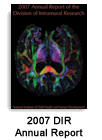Scientific Director's Preface to the 2007 Annual Report
"When Alexander the Great visited Digenes and asked whether he could do anything for the damed teacher, Diogenes replied: 'Only stand out of my light.' Perhaps some day we shall know how to heighten creativity. Until then, one of the best things we can do for creative men and women is to stand out of their light."
For the last three years, the NIH's biomedical research funding level has remained essentially unchanged. Coincident with this trend is the mandate to systematize our work into a framework defined by terms such as translational research, knowledge management, transparency, and impact assessment. Parallel with the move to apply these concepts to creative research is an effort to develop tools to improve the management of complex scientific portfolios, create incubators for multidisciplinary research, and identify areas of fruitful investigation (such as bioinformatics, nanomedicine, epigenetics, phenomics, imaging, and others). The friction between the tug of public accountability under these new systems of classification and what a team of scientists may be exploring every day poses the risk of stifling the sparks of imaginative minds. As leaders of scientific programs, we have the responsibility of balancing our obligations to the public against our need to shield our investigators, but without ever blocking the light.
The NICHD's Division of Intramural Research (DIR) program has to allow the light to penetrate its corridors. Its investigators must have the opportunity to initiate highly creative, high-risk research projects that may affect our understanding of broad biological processes and influence our understanding of health and disease so as ultimately to allow new interventions. The Institutes's mission is to study the phenomena of growth, differentiation, and development, including the acquisition of cognitive and bahavioral skills; its medical objectives are to enhance child health and to focus on reproductive biology medicine. During the past year, the NICHD's research scientists have made important contributions to further the technology of biology, to understand the processes of embryogenesis, and to expand our understanding of the functions of the human brain.
During 2007, the Division of Intramural Research (DIR) made significant scientific advances. In particular, our scientists have:
- Collaborated in the development of a technology (PhotoActivation Localization Microscopy or PALM) that exceeds the light microscope's limits of detection, making possible the detection and monitoring of single particles within the cell;
- Used mutant models in zebrafish to elucidate a pathway of artery specification, established a role for neuronal guidance factors in vascular patterning, illuminated vascular tube formation in vivo, and identified a lymphatic vascular pattern in zebrafish;
- Emplyed retrovirus-mediated RNA interferenceto reveal several unexpected roles of Disrupted-In- Schizophrenia 1 (DISC1) in the development of new neurons in the adult hippocampus, addressed the role of brain-derived neurotrophic factor (BDNF) in depression and anxiety, and proposed that BDNF is a target of antidepressants and that pro- and mature BDNF may play a different and even opposing roles in the brain's stress and reward systems;
- Defined molecular mechanisms by which the neurotransmitter l-glutamate activates ion channels at synaptic membranes; this requires high-resolution structures of the receptor proteins, which are encoded by the 18 genes that co-assemble in different combinations to form tetrameric ligand- gated ion channels;
- Developed an experimental vaccine based on the malaria circumsporozoite protein as well as an additional vaccine based on its surface protein Pfs25 (malaria is a leading cause of morbidity and mortality worldwide, especially in children, and no licensed vaccine is available);
- Developed a unique human lymphoid ex vivo tissue culture system to study HIV pathogenesis; the system supports productive infection with different types of HIV-1 isolates, dissemination of virus throughout the tissue, depletion of CD4+T cells, release of virus into the medium, lymphocyte apoptosis, and a functional immune response.
These are but a few of the accomplishments of members of the NICHD DIR during 2007. Despite these exciting events, the realities of the times mandated a significant reduction in funding support during the second half of the year and the decision to reduce the DIR budget further in fall 2007. Directives calling for "centralization of research," "quantification" of scientific productivity, and analysis of impact impede the ability of intramural and extramural scientists to focus on fundamental biological problems and their solutions. The research community welcomes the opportunity to report its accomplishments, optimize its capacity to use its resources efficiently, and bring creativity and commitment to improve the health of users as the central focus of all its endeavors. It cannot, however, target its efforts to produce a "cure" for obesity, cancer, or heart dieases within 2 or 5 or 10 year; in contrast to the engineering mandate to build a rocketship to fly to the moon, the research community must come to grips with gaps in the knowledge of biology and develop the tools required to achieve its noble research objectives. It must have the freedom to seek answers to fundamental questions, though their applicability may not yet be apprent.
"The only real voyage of discovery consists not in seeing new landscapes, but in having new eyes, in seeing the universe with the eyes of another, of hundreds of others, in seeing the hundreds of universes that each of them sees."
Owen M. Rennert, M.D.
Scientific Director
Eunice Kennedy Shriver National Institute of Child Health and Human Development




